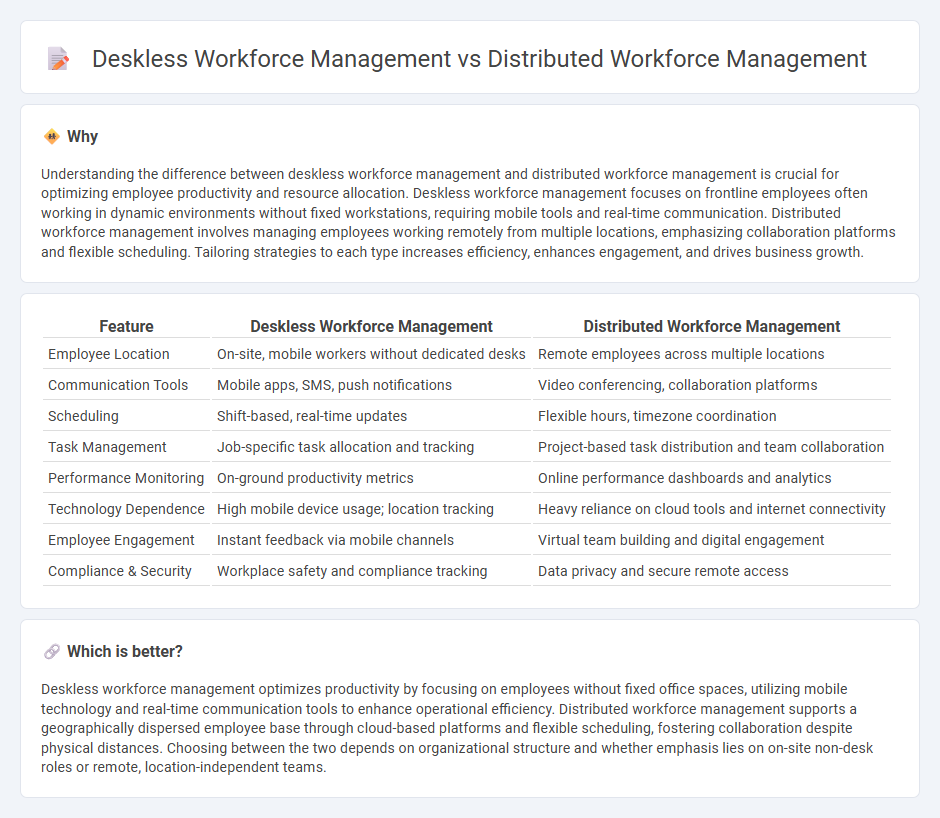
Deskless workforce management focuses on optimizing operations for employees who perform tasks outside traditional office settings, such as retail associates or field technicians, by utilizing mobile technologies and real-time communication tools. Distributed workforce management involves coordinating a geographically dispersed team across multiple locations, emphasizing seamless collaboration, virtual connectivity, and flexible scheduling to maintain productivity. Explore how businesses leverage these distinct strategies to enhance workforce efficiency and engagement.
Why it is important
Understanding the difference between deskless workforce management and distributed workforce management is crucial for optimizing employee productivity and resource allocation. Deskless workforce management focuses on frontline employees often working in dynamic environments without fixed workstations, requiring mobile tools and real-time communication. Distributed workforce management involves managing employees working remotely from multiple locations, emphasizing collaboration platforms and flexible scheduling. Tailoring strategies to each type increases efficiency, enhances engagement, and drives business growth.
Comparison Table
| Feature | Deskless Workforce Management | Distributed Workforce Management |
|---|---|---|
| Employee Location | On-site, mobile workers without dedicated desks | Remote employees across multiple locations |
| Communication Tools | Mobile apps, SMS, push notifications | Video conferencing, collaboration platforms |
| Scheduling | Shift-based, real-time updates | Flexible hours, timezone coordination |
| Task Management | Job-specific task allocation and tracking | Project-based task distribution and team collaboration |
| Performance Monitoring | On-ground productivity metrics | Online performance dashboards and analytics |
| Technology Dependence | High mobile device usage; location tracking | Heavy reliance on cloud tools and internet connectivity |
| Employee Engagement | Instant feedback via mobile channels | Virtual team building and digital engagement |
| Compliance & Security | Workplace safety and compliance tracking | Data privacy and secure remote access |
Which is better?
Deskless workforce management optimizes productivity by focusing on employees without fixed office spaces, utilizing mobile technology and real-time communication tools to enhance operational efficiency. Distributed workforce management supports a geographically dispersed employee base through cloud-based platforms and flexible scheduling, fostering collaboration despite physical distances. Choosing between the two depends on organizational structure and whether emphasis lies on on-site non-desk roles or remote, location-independent teams.
Connection
Deskless workforce management and distributed workforce management both focus on optimizing productivity and communication for employees operating outside traditional office settings. Deskless workforce management targets mobile and on-site workers by leveraging tools like mobile apps, real-time tracking, and task scheduling to enhance operational efficiency. Distributed workforce management expands this approach by coordinating remote teams across various locations using cloud-based platforms, ensuring seamless collaboration and resource allocation.
Key Terms
**Distributed workforce management:**
Distributed workforce management leverages digital tools and cloud-based platforms to coordinate employees working remotely across multiple locations, ensuring seamless communication and productivity. Key components include real-time task tracking, secure access to company resources, and performance analytics tailored to remote environments. Discover more about how innovative strategies optimize distributed workforce efficiency and collaboration.
Remote collaboration
Distributed workforce management emphasizes coordinating employees working from various geographic locations using cloud-based platforms, real-time communication tools, and centralized task tracking to enhance remote collaboration efficiency. Deskless workforce management targets mobile, frontline employees without fixed workstations, leveraging mobile apps and location-based technology to streamline operations and maintain seamless connectivity. Explore how integrating both approaches can optimize remote collaboration across diverse workforce profiles.
Time zone coordination
Time zone coordination in distributed workforce management poses challenges in scheduling meetings and ensuring real-time collaboration across global locations. Deskless workforce management emphasizes dynamic shift planning and communication tools tailored to field workers operating in varying time zones. Explore effective strategies to optimize time zone coordination for both workforce types.
Source and External Links
What Is a Distributed Workforce? Benefits + Best Practices - Effective distributed workforce management involves setting clear expectations, encouraging frequent communication, and hiring self-motivated employees who can work independently across different locations.
A Complete Guide To Distributed Workforce For Businesses - Key strategies for managing a distributed workforce include establishing robust communication channels, providing essential resources, fostering collaborative culture, and prioritizing employee well-being.
What is a distributed workforce and how do you manage it? - Successful management relies on digital collaboration tools, monitoring productivity, maintaining regular communication, supporting employee engagement, and offering ongoing training and recognition.
 dowidth.com
dowidth.com